Home / Email signature examples / Email sign offs
Best email sign-offs for any occasion (search by category)
Find the right sign-off for the right recipient, on the right occasion. Browse our comprehensive list.

What makes a good email sign-off?
Good email sign-offs that are tailored to the recipient, the topic, and the emotional tone of your email are an integral part of any email you send. A good email ending would emphasize your main message relating to the email topic. The best sign-off will also add a positive emotional tone that’s considered by your specific reader to be socially appropriate.
Best email sign-offs for professionals
Best
All the best
Best wishes
Best regards
Sincerely
Respectfully
Regards
Warm regards
Kind regards
Thank you
Thank you in advance
Common casual email sign offs
Talk again soon
See you soon
Glad to help
Thanks
Thanks for your help
Thanks in advance
Best
Have a great day
Take care
Keep me posted
I’ll keep you posted
What’s on this page
How to sign off an email?
The best email sign-offs do 3 things:
- It fits the context of your email message
- It reflects how familiar and friendly you are with the recipient
- It refers to the main emotion or request conveyed in the email
Your sign-off right can be hugely influential on how your reader perceives you. According to behavioral economist Daniel Kahneman, the end of an experience strongly determines the way we go on to remember that experience. Take this into account, when you decide what sign off to use to end any important email.
That said, if the email is not so important, if it’s just another email, a short message, or one message in a long string, your sign-off may not be so influential, and it may even go unnoticed. In that case, you could simply skip a sign-off altogether and go about your day with a sound mind.
The bottom line is that you know better than anyone what the right sign-off is for a given action. But this does not mean that you’re left only with your gut feeling to work with. We have an easy technique to help you know what’s right. Let’s jump right in.
What is the best way to sign off your emails?
Email sign-offs are an essential component of email overall, though they have expanded and adapted to other platforms as well. All the best email sign-offs set the final impression of the message and seal the tone. Without them, your email may fall flat. As mentioned, your choice of email sign-off completes the impression someone gets reading your email. That means not giving it any thought can change the whole impression the client or your boss gets while reading. Talk about not finishing with a bang.
All the best email sign-offs: your default option
All the best email sign-offs are general, friendly but slightly formal sign-offs; like “best regards” or “all the best”. If you expect to see or meet the recipient shortly then you can end your email with “I look forward to speaking with you” or “I look forward to meeting you”.
Ask yourself these 4 questions to nail your email sign-off every time
- What is the main message of my email?
- What is the emotion I want to convey to the recipient?
- Is this email formal or informal?
- Does the recipient know me?
How do these 3 questions provide clarity
let’s consider the following example:
I wrote an email to my manager requesting a raise. In my email, I spelled out my accomplishments, my contribution to the team, and my dedication to the company.
I can answer the questions as follows:
- I want to be considered for a raise
- Dedication
- Formal
- We know each other
In this case, I should go for a formal sign-off that refers to my request and conveys my feelings of dedication. I’ll end my sign-off with my name for a personal emphasis, and since my manager knows me I’ll use only my first name so that I won’t come across as emotionally distant and overly formal.
The result:
Please consider my request, with dedication,
John
Which email sign-offs are safe to use?
YouGov conducted a survey asking 1,000 adults what their preferred email sign-off was. Respondents were allowed to report more than one answer (the survey page has meanwhile gone down so we have no link, sorry).
These survey results can tell us a bit about what sign-offs are most commonly used but not much about how these sign-offs are received; whether they produce positive or negative sentiment.
This being the case I would treat these stats as widely considered safe options, and not as any form of hard fact or best practice guidelines.
How to avoid sending annoying or inappropriate email sign-offs?
In the realm of digital etiquette, email sign-offs are a gray area. What some find polite, others may interpret as passive-aggressive. A simple “Cheers” could upset long-established relationships.
Online, there’s a spectrum of conflicting views. Business Insider critiques most options as insincere or a power-play, while The Telegraph labels “Best” as “vulgar” and “lazy.”
This disagreement could stem from email’s fluid role between formal and informal communication. HuffPost and YouGov’s survey found that 17% saw emails as formal, 33% as informal, and 49% said it depends.
Interestingly, 41% of respondents found no email sign-off annoying. However, “xoxo,” “Peace,” and no signature irritated some. Only 3% found “Thanks” bothersome, making it the least controversial option.
The most commonly reported sign offs in the YouGov poll were:
- “Thanks” 62%,
- Just a name or initials – 46%
- “Sincerely” – 44%
- “Love” – 28%
- “Regards” – 22%
- No signature at all – 21%
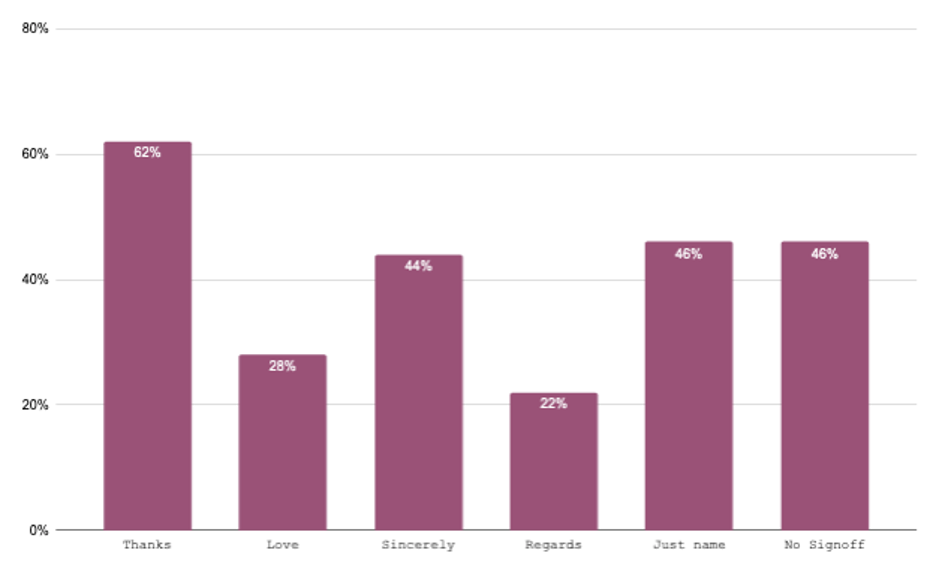
How to sign off an email with multiple names
When signing off an email with multiple names, such as co-workers or corporate members. The person who is writing the email will put their name and team name or they will mention the title of the person who ranks higher in the organization for example:
- Best,
(first name, last name) and the (company name/ department) - Best regards,
CEO John Doe, and team
Email sign off examples for any correspondence
Navigating the realm of email etiquette can be tricky, and it all ends with that crucial sign-off. Here, we have compiled a comprehensive list of versatile email sign-off examples, tailored to suit any occasion or context. Whether it’s professional correspondence or a friendly catch-up, we’ve got you covered.
Sick days email sign-offs
After COVID, we have gotten used to sending Sick\Not Sick Email sign-offs to our friends, colleagues and customers. following the best examples for sick days email sign-offs.
Not sick
Keep safe and healthy
Hope you and your family are safe and healthy during these unpredictable times
Hope you’re making it through this pandemic
Stay safe
Stay positive
Be well!
Have a socially distant [day, week]
Take care, we’ll get through this
Let’s hope for the best
Hope things will improve soon
Sick
Get well soon
Hope you feel better soon
Hang in there
Be well
Take it one day at a time
Take it easy
Hope you have a quick and easy recovery
Wishing you a speedy recovery
Our thoughts are with you
Our prayers are with you
Formal Sign-offs
Formal sign-offs are used for closing an email when communicating with someone in a professional or interest-based setting. Even if you know each other it’s best to remain formal when you are not equal in authority, rank, or social standing.
There are many kinds of formal sign-offs depending on the special circumstances for which they are used. Just click any of the jump links in the list below to get to where you need.
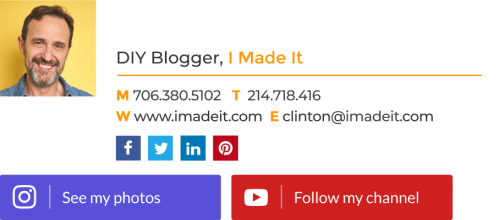
Business & workplace sign offs
The correct sign-off etiquette in business or work can change widely depending on the situation and social context. Like all social interactions, try to say what you mean without being too blunt, pushy, or distant, or it may come off as awkward.
To help you find what you need, we broke down your formal business sign-off options based on the type of relationship between you and your recipient.
If your company has a casual social atmosphere, as is often the case with small family companies or young startups, then making a unique informal business sign-off may be more suitable for you.
Manager to employee
- Keep up the great work
- Thank you for your hard work
- Great job on the [task, project, sale]
- Thanks for the update
- Please keep me updated about [task, progress, inquiry]
- Please see to it that [a task is done]
Employee to superior
- Thank you
- Thank you in advance
- I appreciate you taking the time
- Sincerely
- Respectfully
- I will keep you updated, best regards
- I am on it, and I will keep you updated
- I apologize for the [misunderstanding, mistake], I will make sure that it does not happen again
- Please let me know how you want me to proceed
- Please consider my request, thank you in advance
Coworkers and colleagues
This type of sign-off can be fairly casual, but it depends on the atmosphere in your workplace and the specific colleague you’re writing to. Between peers, It’s easy to be weirdly formal but just as easy to be too warm to make some people uncomfortable. The best approach is to go with your gut.
- Best
- Thanks
- Thanks so much for your [help, advice, time, etc.]
- Take care
- Cheers
- Talk to you [later, tomorrow, next week]
- Until next time
- Keep me updated, OK?
- Let’s get to it!
- Great working with you
Outreach sign offs
- Please take a look and let me know what you think
- I look forward to hearing what you think
- Thank you for your time, looking forward to hearing back from you
- Hope you like my offer, please let me know how you wish to proceed
- I am at your disposal for any questions or concerns you may have
- If you have any question, don’t hesitate to shoot me an email
Business to client sign offs
B2C email sign-offs are crucial for proper business communications and can sometimes even help “close the deal” if done right.
A prospective customer or new client
- If you have further questions, please let me know
- Let me know if there is anything else that I can help you with
- Don’t hesitate to contact me if you have any questions or concerns
- Thank you for your interest in doing business with us
- Thank you for your time and attention
- Looking forward to doing business with you
- Looking forward to helping you grow your business
- Looking forward to hearing from you
- I look forward to meeting you
- Looking forward to working with you
- Best regards
- Warm regards
- Kind regards
- All the best
Customer support
- Let me know if there is anything else I can help you with
- Did this answer your question?
- Let me know if there is anything else I can do for you
- Please let me know if there is anything else I can help you with
- Here to help
- Let me know if the problem persists
- Let me know if that helps
Job seeker sign-offs
An email sign-off for job seekers should be sincere and assertive but polite. You do not want to look needy nor do you want to look pushy.
- I look forward to hearing from you
- I appreciate your time and hope to hear from you soon
- Thank you for your consideration
- Thank you for this opportunity
- Hope to hear back from you, with thanks
If you want more confidence that you’re making the right choice when you send your next job application email – take a look at this deeper guide for job seeker sign-offs.
Academic sign-offs for use in college or university
An academic email sign-off is one of the easiest to pull off. The most commonly placed sign-offs are the most appropriate. The most used sign-offs may very well have been established in the context of academic correspondence in universities, colleges, or research centers.
A student’s sign-off when emailing her professor should be formal and respectful.
A professor’s sign-off when emailing her student should be formal but can establish a softer, warmer connotation.
Student to professor/teacher
- All the best
- Best Wishes
- Best regards
- Respectfully
- Regards
- Thank you
- Thank you in advance
Teacher/professor to student
- Best regards
- Warm regards
- Kind regards
- All the best
- Best Wishes
- Warm wishes
- Warmly
- Thank you
Military sign offs
V/R or respectfully are formal email sign-offs used in the military and may also be appropriate for government officials and clergy. These sign-offs are too formal for most email communications. They should be reserved for addressing an authoritative figure in a hierarchical organization or community.
- V/R
- Very respectfully
- Respectfully
- Respectfully yours
Informal email sign offs
Informal email sign-offs are practically endless. No conversion binds you to a set list of proper ways with which to end your email. Still, you should be mindful that you’re not crossing the line from friendly and playful into awkward or even offensive.
There are many kinds of informal sign-offs. The correct informal sign-off to use depends on how close you are to the person you’re emailing as well as the email topic. To get to what you specifically need just click any of the jump links in the list below.
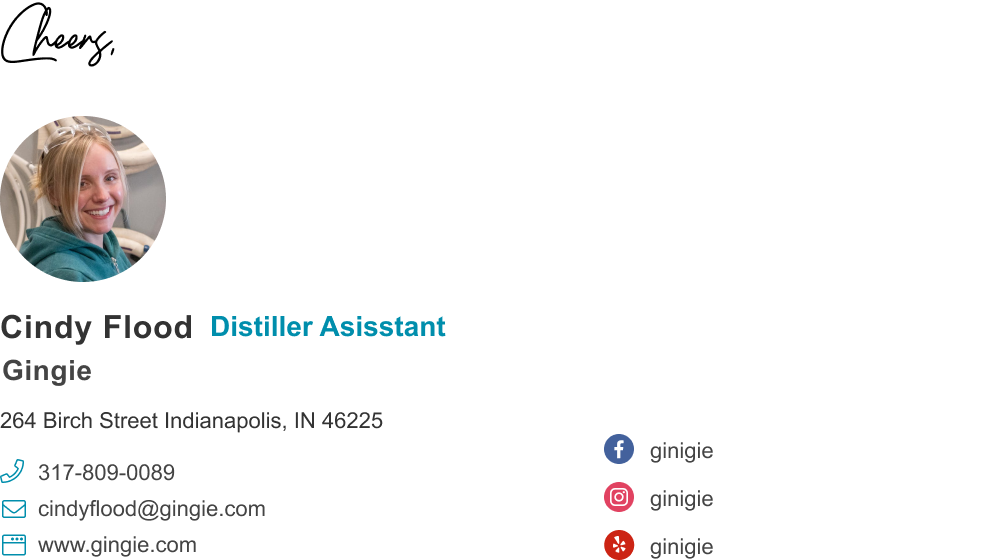
Casual and friendly sign-offs
Casual email sign-offs are used to send an email between people who are well acquainted with one another. The deciding factor of whether to use a casual (rather than formal) email sign-off is if the person you are addressing knows you and sees you as a person beyond your job title.
Sometimes you may feel closer to someone than they feel about you. Be sure to take your recipient’s perspective of your relationship rather than your own.
- Peace
- My best
- As ever
- Talk soon
- See you soon
- Cheers
- Thx
- Have a great day
- Take care
- Take it easy
- See you around
- Ciao
- Enjoy your day
- Have a good one
- Toodles
Between friends
Truly for this one, you don’t need our help. Between friends, any sign-off will do, and even no sign-off at all. Make it as weird as you like, just say sorry later 🙂
- Later
- See ya
- Talk again soon
- later gator
- Hasta la vista
- Ciao
- Love ya
- Fare thee well
- You’re ma boy
- Take it easy
- [A GIF]
Unique sign-offs for different needs
A unique sign-off approach is best used for informal business sign-offs. A unique sign-off is simply one that addresses your email’s main concern and finetunes its emotional tone to what you want to convey. Just be sure to keep it socially appropriate.
In a perfect world, you’d make a unique sign-off for all your emails. Uniqueness doesn’t mean writing something witty that’s never been read before – it means writing a sign-off that’s meaningful to your reader. For starters, you can play with some of our more conservative templates below.
Complete any of the following template options:
- Looking forward to working with you on [task, job, event, etc.]
- Can’t wait to hear what you think about [suggestion, idea, solution, project, etc.]
- Congratulations on your [success, nomination, promotion, contract, etc.]
- Thanks for your time, please send my regards to the [team, volunteers, partners, board of directors, etc.]
- I feel that our cooperation on [topic] would immensely benefit both sides
- I will consider your request for [a raise, donation, cooperation, team up, etc.] and get back to you
- I would greatly appreciate it if you could [get back to me, send my order, fulfill a reimbursement, etc.]
- Hope you enjoy our [product, service, event, etc.], please feel free to contact me with any further questions or concerns
Funny sign-offs
It’s never a bad idea to make people smile. Funny sign-offs can do just that for whoever it is that’s reading your email. Just remember that sign-offs work well when they are attuned to the right social context. So, it’s best to keep the jokes and laughs for people that feel very familiar with you.
- Later gator
- Stay awesome
- BTW, you look so cute when you read my emails
- No need to thank me for this email
- Did you get all that? Cause I can send it again…
- Have a great procrastination
See our guide packed with funny email signatures and sign offs.
Spiritual sign-offs
- Peace and love
- Sending Good Vibes
- Peace
- Shalom
- Salam
- Namaste
- May you be filled with loving-kindness
- Set your heart on doing good
- Smile at the world and the world will smile back
- Enjoy this moment
- Follow your heart
- Stay true to yourself
- May you be peaceful and at ease
- May you be happy
- May the force be with you
Sign-offs that convey emotions
Emotions email sign-offs are email endings that pass an emotional tone directly, or ever so subtly (most often positive wishes or attitude). Emotional sign-offs come mainly in informal forms but some are considered formal; such as “Warm wishes” or “Kind regards”.
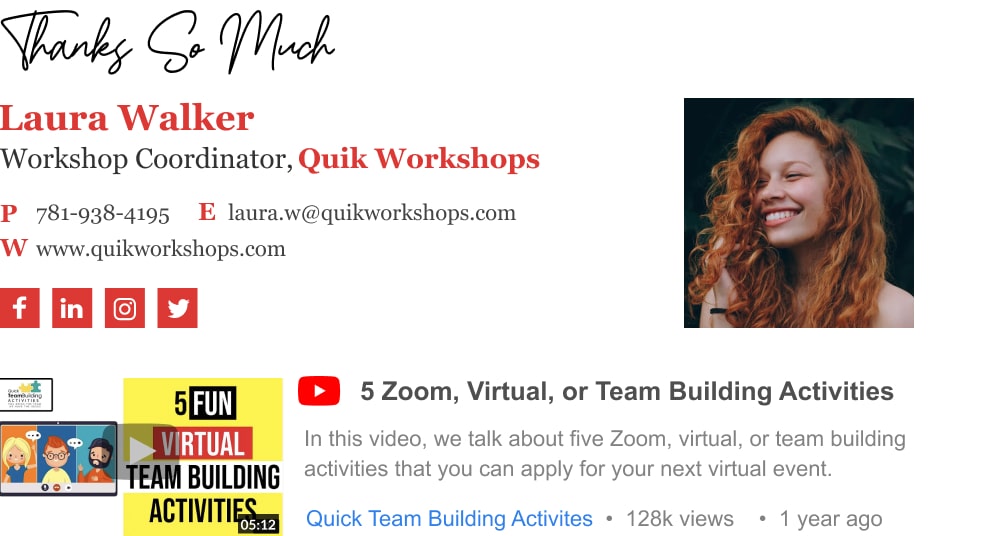
‘Thank you’
“Thank you” email sign offs are naturally used at the end of an email message to thank your recipient for something they did. Thankful sign-offs are best used when you are actually thanking your email recipient for something specific.
- Thanks in advance
- Thank you
- Thanks
- Thanks!
- Thanks again
- Cheers
- Much appreciated
- Much obliged (UK)
- With gratitude
- Many thanks
- I can’t thank you enough
- Thank you for taking the time
- Thank you for your consideration
- Thanks so much
- Many thanks
- Thx
- Thanking you in anticipation
- With appreciation
- Thank you again for your [help, time, patronage, support, etc]
Warm
- Kind regards
- warm regards
- Warm wishes
- Best
- Sincerely
- Regards
- Kind regards
- Warm Regards
- Warmly
- You’re an inspiration
Congratulations
- Congrats
- Congratulations
- Congratulations on [promotion, new baby, success, etc.]
Loving
- Love
- XX
- XOXO
- Yours
- Yours truly
- Hugs
- Faithfully
- Sending you my love
- With love
Condolences
- Our thoughts and prayers are with you
- I am so sorry for your loss
- My condolences
- Please accept my heartfelt sympathies for your loss
- My deepest sympathy
- My heart is with you
Bad news
- I’m sorry for having to tell you this, I sincerely
- This is truly unfortunate, I’m sorry
- I’m sure that this comes as a shock, stay strong
- I’m sorry, I wish you good luck
- I know this is upsetting, and I’m sorry
Browse email sign-off templates
Simply scroll down to the section that fits your specific needs.

Holiday and religious sign offs
Religious sign-offs are mostly holiday greetings. For most people living in the US, a ‘Happy Holiday’ greeting will suffice. But if you want to get more specific you can end your email with the actual holiday name, e.g. ‘Happy Hanukkah’ or ‘Happy New Year’.
Other kinds of religious sign-offs are accepted daily greetings within a religion or a culture. Such as ‘God bless’ in some Christian communities, ‘Shalom aleichem in some Jewish communities, and ‘as-salam alaykum’ in some Muslim communities.
Depending on the occasion, some religious sign-offs are more spiritual and are mostly used between believers of the same faith. Make sure you’re not giving the impression that you’re part of the faith when you’re not, or you risk offending your recipient.
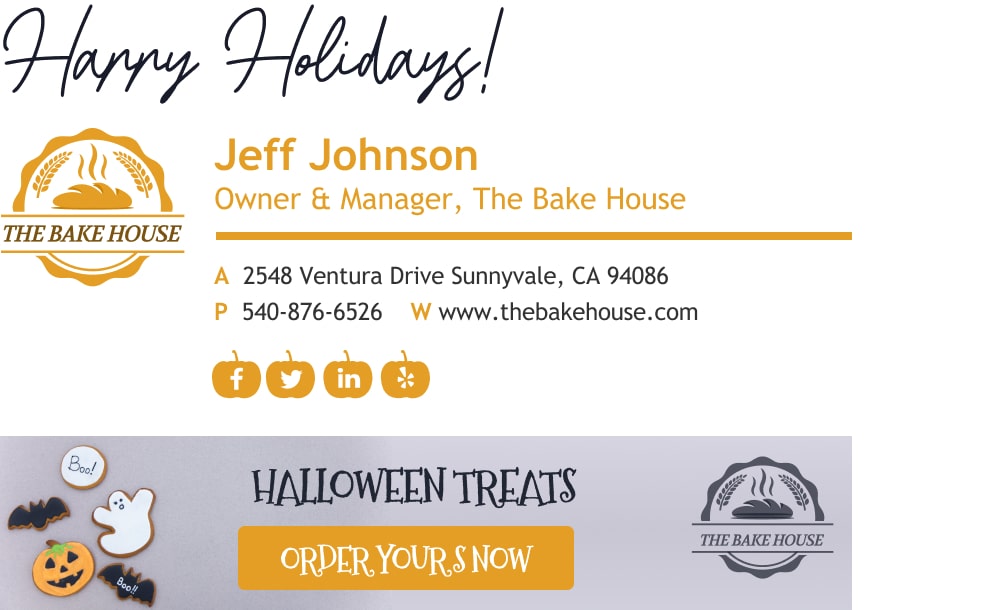
Christian sign offs
- Don’t Stop Believin’
- Have a blessed day
- God bless
- Blessings
- Have a blessed holiday filled with happiness, love, and faith
- Happy holiday
- Merry Christmas
- Have a merry Christmas and a happy New Year
- Happy Thanksgiving!
- Happy Halloween
Jewish sign offs
- Shalom
- Shalom aleichem
- Shabbat shalom (say this on Friday before sabbath)
- Chag sameach (Happy holiday)
- Shana Tova (happy new year)
- G’mar Chatima Tovah (say this on Yom Kippur)
- Mazal tov (say this on birthdays or when having a new child)
- Happy Hanukkah
- Happy Passover
- Happy Sukkot
Muslim sign offs
- as-salam alayka – Sigle, Masculine
- as-salāmu alayk – Single, Feminine
- Eid Mubarak (say on Eid al-Adha and Eid al-Fitr)
Hindu sign-offs
- God bless you with prosperity and happiness
- I wish you happiness and prosperity
- May this Diwali open the doors of wealth and success for you and your family
- Happy Diwali
- Happy Onam
- Happy Dussehra
- Happy dhanteras
Final words
In closing, we hope this article has shed some light on the topic at hand, providing insights and valuable takeaways regarding email sign-offs. The conversation, we believe, should not end here, but continue in various forms, ensuring that we continue to learn and grow together. We invite your thoughts, insights, and criticisms, as they can only serve to enrich the dialogue.
Please feel free to share this article with anyone who might find it informative or beneficial. We’re always eager to engage with our readers, so don’t hesitate to leave comments or reach out to us directly.
Once again, thank you for taking the time to read our work. Stay tuned for more informative and thought-provoking articles in the future.
Best Regards,
The WiseStamp team
- Email signature examples
- Examples by profession
- CEO & executive
- Owner & founder
- Realtor
- Lawyer
- JD candidate
- Student
- Teacher
- Academic
- Doctor
- Nurse
- Blogger & writer
- Photographer
- Graphic designer
- Musician
- Artist
- Military
- Engineer
- Assistant
- Consultant
- Marketing & sales
- Job-seeker
- Startup
- Contractor
- Examples by feature
- Clickable email signatures
- Email disclaimer
- Quote email signature
- Green signature footers
- Banner email signatures
- Social media icons email signatures
- Instagram email signature
- Linkedin email signature
- Animated GIF signatures
- CTA email signatures
- Google Maps email signature
- Video email signatures
- Email sign off examples
- Examples by design
- Personal email signature
- Cool email signature
- Funny email signatures
- Minimalist email signature
- Simple email signature
Free email signature generator
Popular features:
- 1-Click setup in your email
- Designed template options
- Add-ons for every need
- Email signature examples
- Examples by profession
- CEO & executive
- Owner & founder
- Realtor
- Lawyer
- JD candidate
- Student
- Teacher
- Academic
- Doctor
- Nurse
- Blogger & writer
- Photographer
- Graphic designer
- Musician
- Artist
- Military
- Engineer
- Assistant
- Consultant
- Marketing & sales
- Job-seeker
- Startup
- Contractor
- Examples by feature
- Clickable email signatures
- Email disclaimer
- Quote email signature
- Green signature footers
- Banner email signatures
- Social media icons email signatures
- Instagram email signature
- Linkedin email signature
- Animated GIF signatures
- CTA email signatures
- Google Maps email signature
- Video email signatures
- Email sign off examples
- Examples by design
- Personal email signature
- Cool email signature
- Funny email signatures
- Minimalist email signature
- Simple email signature
We use cookies on our website to make sure you get the best experience from your visit. Please confirm that you accept the use of cookies & our privacy policy.
